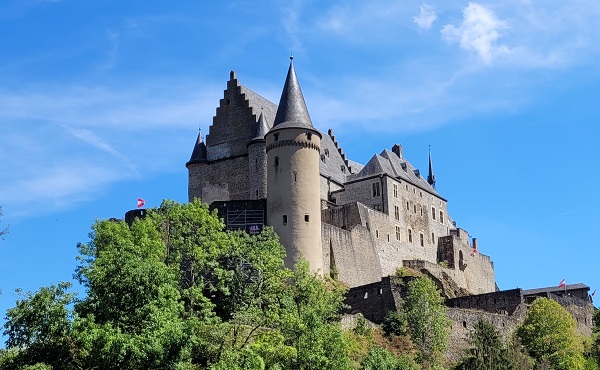 Château de Vianden;
Credit: Jazmin Campbell / Chronicle.lu
Château de Vianden;
Credit: Jazmin Campbell / Chronicle.lu
Chronicle.lu has teamed up with local author and tour guide David Heal of Luxembourg Battles for a new historical series.
Based on David Heal's extensive research spanning several decades (and documented in the form of place-name index cards), the series aims to present interesting local historical events and facts linked to places in (and around) Luxembourg.
Next up is a look at the history of the town of Vianden, which dates back many centuries. Today, the dominant feature is the castle on the top of the hill. And that certainly dates back to early medieval times. David said he suspected it may even date back to the Iron Age, pre-Roman times - the castle is certainly in the right position. The Count of Vianden was a very important person and held larger lands than the Count of Luxembourg (although one possible myth suggests the family had a talent for losing all their money gambling...). The castle remained the seat of the counts of Vianden up until the early 15th century, later passing to the House of Nassau.
A peculiarity of the town is that half of it is to the east of the Our where one might expect it to be Germany. This dates back to the end of the Napoleonic Wars. The Treaty of Vienna laid down that wherever possible frontiers should be rivers, ridges or another obvious place. The people laying out the frontier down the Our decided that splitting Vianden in two down the river would be ridiculous, so they took the frontier up a ridge to the north of the town (there used to be a large metal flag marking the rock outcrop) around the ridge to the rear of the town and then back down to the now outskirts, thus keeping the whole of the town in Luxembourg. However, this treaty bankrupted the Count. Almost all his lands were in what had become Germany, David explained.
Eventually, the story goes, the townspeople wanted their debts paid and they confiscated the castle and tore off the roof and other parts in payment and used them to rebuild their homes, and so on, leaving the castle a roofless ruin. Another version is that the Mayor of Vianden bought the castle and took it apart, selling its doors, windows, roof parts, etc. In any case, the castle remained in decay until the late 1970s / early 1980s when it was taken over by the State and rebuilt as one sees it today.
Another interesting point, according to David, is that when World War One started in 1914, there were British tourists in the town. One was a British army cadet and he immediately left for Britain - without leaving his name. There was also a British couple who stayed on (or rather were too slow getting away), the Gribbles, and who were not allowed to leave. They ended up in an internment camp in Germany. The man, Francis Gribble, was a well-known writer and he wrote the book, In Luxembourg In Wartime, which can occasionally be found on second-hand stalls. He describes going for a walk on 2 August 1914 towards the German border and finding that the border had been “sealed” – by hanging a chain across the road and withdrawing the guards!
After the first liberation of September 1944, the town was the frontier (and the German side of the river was in German hands). The Resistance ran a ferry service across the river at night, and legally the town was held not by the US Army but by the Luxembourgers. There was a special organisation, the Viener Milice, composed of Luxembourgish German army deserters, members of the Resistance, and so on.
The Battle of the Bulge virtually destroyed the town, so what one sees today is mostly post-war. The bridge across the river and the Victor Hugo house (worth visiting) are both post-war reconstructions, concluded David.








